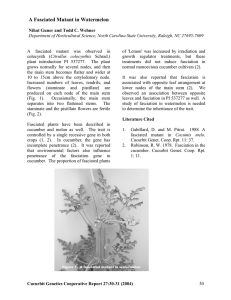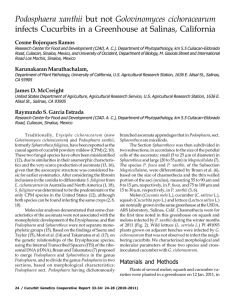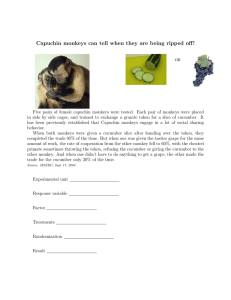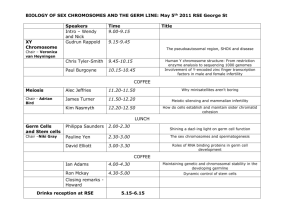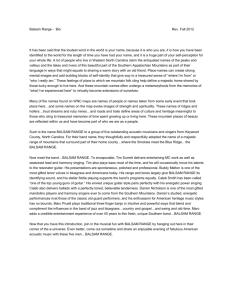Sphaerotheca fuliginea Poll.
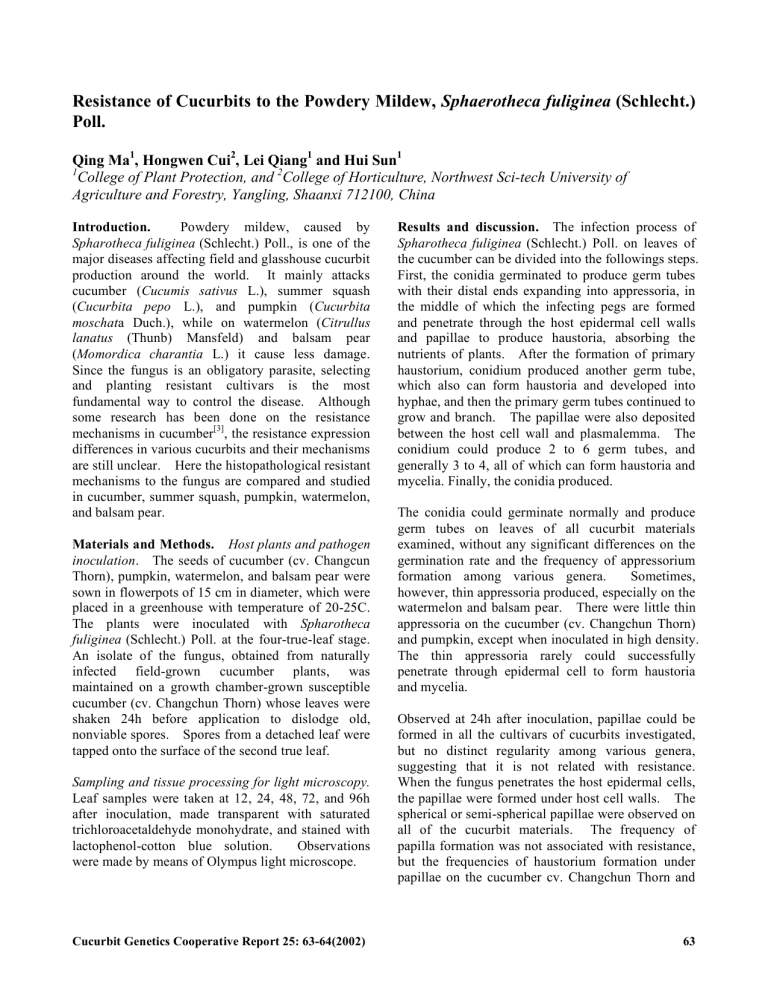
Resistance of Cucurbits to the Powdery Mildew, Sphaerotheca fuliginea (Schlecht.)
Poll.
1
Qing Ma
1
, Hongwen Cui
2
, Lei Qiang
1
and Hui Sun
1
College of Plant Protection, and
2
College of Horticulture, Northwest Sci-tech University of
Agriculture and Forestry, Yangling, Shaanxi 712100, China
Introduction. Powdery mildew, caused by
Spharotheca fuliginea (Schlecht.) Poll., is one of the
Results and discussion. The infection process of
Spharotheca fuliginea (Schlecht.) Poll. on leaves of major diseases affecting field and glasshouse cucurbit production around the world. It mainly attacks cucumber ( Cucumis sativus L.), summer squash
( Cucurbita pepo L.), and pumpkin ( Cucurbita moschat a Duch.), while on watermelon ( Citrullus lanatus (Thunb) Mansfeld) and balsam pear
( Momordica charantia L.) it cause less damage.
Since the fungus is an obligatory parasite, selecting and planting resistant cultivars is the most fundamental way to control the disease. Although some research has been done on the resistance mechanisms in cucumber [3] , the resistance expression differences in various cucurbits and their mechanisms are still unclear. Here the histopathological resistant mechanisms to the fungus are compared and studied in cucumber, summer squash, pumpkin, watermelon, and balsam pear.
Materials and Methods. Host plants and pathogen inoculation . The seeds of cucumber (cv. Changcun
Thorn), pumpkin, watermelon, and balsam pear were sown in flowerpots of 15 cm in diameter, which were placed in a greenhouse with temperature of 20-25C.
The plants were inoculated with Spharotheca fuliginea (Schlecht.) Poll. at the four-true-leaf stage.
An isolate of the fungus, obtained from naturally infected field-grown cucumber plants, was maintained on a growth chamber-grown susceptible cucumber (cv. Changchun Thorn) whose leaves were shaken 24h before application to dislodge old, nonviable spores. Spores from a detached leaf were tapped onto the surface of the second true leaf.
Sampling and tissue processing for light microscopy.
Leaf samples were taken at 12, 24, 48, 72, and 96h after inoculation, made transparent with saturated trichloroacetaldehyde monohydrate, and stained with lactophenol-cotton blue solution. Observations were made by means of Olympus light microscope. the cucumber can be divided into the followings steps.
First, the conidia germinated to produce germ tubes with their distal ends expanding into appressoria, in the middle of which the infecting pegs are formed and penetrate through the host epidermal cell walls and papillae to produce haustoria, absorbing the nutrients of plants. After the formation of primary haustorium, conidium produced another germ tube, which also can form haustoria and developed into hyphae, and then the primary germ tubes continued to grow and branch. The papillae were also deposited between the host cell wall and plasmalemma. The conidium could produce 2 to 6 germ tubes, and generally 3 to 4, all of which can form haustoria and mycelia. Finally, the conidia produced.
The conidia could germinate normally and produce germ tubes on leaves of all cucurbit materials examined, without any significant differences on the germination rate and the frequency of appressorium formation among various genera. Sometimes, however, thin appressoria produced, especially on the watermelon and balsam pear. There were little thin appressoria on the cucumber (cv. Changchun Thorn) and pumpkin, except when inoculated in high density.
The thin appressoria rarely could successfully penetrate through epidermal cell to form haustoria and mycelia.
Observed at 24h after inoculation, papillae could be formed in all the cultivars of cucurbits investigated, but no distinct regularity among various genera, suggesting that it is not related with resistance.
When the fungus penetrates the host epidermal cells, the papillae were formed under host cell walls. The spherical or semi-spherical papillae were observed on all of the cucurbit materials. The frequency of papilla formation was not associated with resistance, but the frequencies of haustorium formation under papillae on the cucumber cv. Changchun Thorn and
Cucurbit Genetics Cooperative Report 25: 63-64(2002) 63
pumpkin were much higher than those on watermelon and balsam pear. The formation of haustoria marks successful penetration, thus the penetration rate differs among different cucurbit materials and hausturium formation rate also differs in the later period of infection.
Resistance was not related with the number of germ tubes at a single infection site, but related with the branch capacity of mycelia. The branches of mycelia in cucumber cultivar Changchun Thorn and pumpkin are greater than those in watermelon and balsam pear, forming larger clone. 96h after inoculation, the lengths of clones on cucumber
‘Changchun Thorn’, pumpkin, watermelon and balsam pear were 899.67, 813, 371.3 and 236.7µm, respectively, showing the resistance in those cucurbits was increasing in the above order.
The times when the host cell starts to necrotize vary among the different cucurbits. More epidermal cell necrosis occurs at 24h after inoculation in watermelon and at 48h in balsam pear, and a little necrosis occur in cucumber ‘Changchun Thorn’ and pumpkin in later periods of inoculation.
This study examined the interaction of cucurbits with
Spharotheca fuliginea (Schlecht.) Poll. by whole leaf transparency, revealing out the histopathological characteristics of cucurbit resistance to powdery mildew and providing some evidence for resistant breeding.
The development process of cucurbit powdery mildew differs somewhat with that of wheat powdery mildew, in which the conidium first produces a primary germ tube, then the primary germ tube stops development, and the conidium produces a secondary germ tube, which develops into mycelium and produces haustorium to penetrate the wheat. Thus the conidium of wheat powdery mildew generally produces mycelium from a single germ tube to form a clone, whereas the cucurbit powdery mildew produces many germ tubes, and all of which can produce haustoria and develop into mycelia.
The function of papillae in resistance to powdery mildews has been studied extensively in other crops [1] .
The production of papillae is believed to be the widespread response of host plants to the fungal penetration. It is found in the resistance research on wheat powdery mildew that the frequency of papillae is not related with the resistance level, but related with haustorium formation under papillae. The functions of papillae in resistance might be related with the time, components, and hardness of papilla occurrance [2] . More cytochemical research is needed.
Hypersensitive response is thought to be the most essential resistance reaction in host plants. The hypersensitive response occurs later in balsam pear.
Thus whether there exists any other resistance mechanisms in balsam pear needs to be further studied.
Literature cited
1.
Koga, H., Bushnell, W.R., and Zeyen R J. 1990.
Specificity of cell type and timing of events associated with papilla formation and hypersensitive reaction in leaves of Hordeum vulgare attacked by Erysiphe graminis f. sp. hordei . Can. J. Bot. 68: 2344-2352
2.
Ma, Q. and Cui H. 1996. The relationship between papilla formation and resistance of cucumber to Sphaerotheca fuliginea (Schlecht.)
Poll. Cucurbit Genetics Cooperative Report 19:
30-31
3.
Ma, Q., Cui, H., Zang, G., Shi, Y., and Qiu, G.
1996. Histopathology on the cucumber resistant to Sphaerotheca fuliginea (Schlecht.)
Poll. Acta Agri. Bor.-occid. Sinica. 5(3): 1-4
Cucurbit Genetics Cooperative Report 25: 63-64(2002) 64

